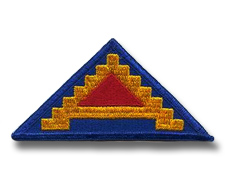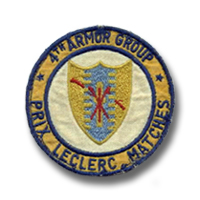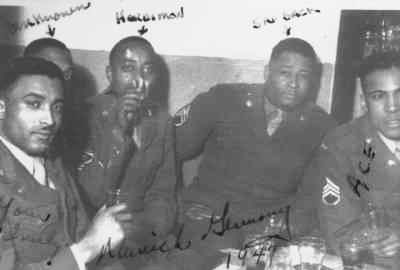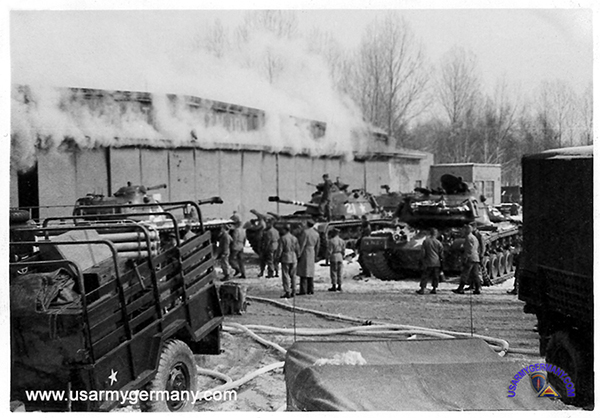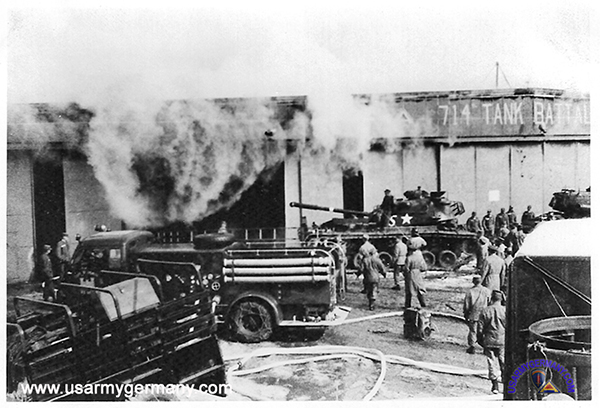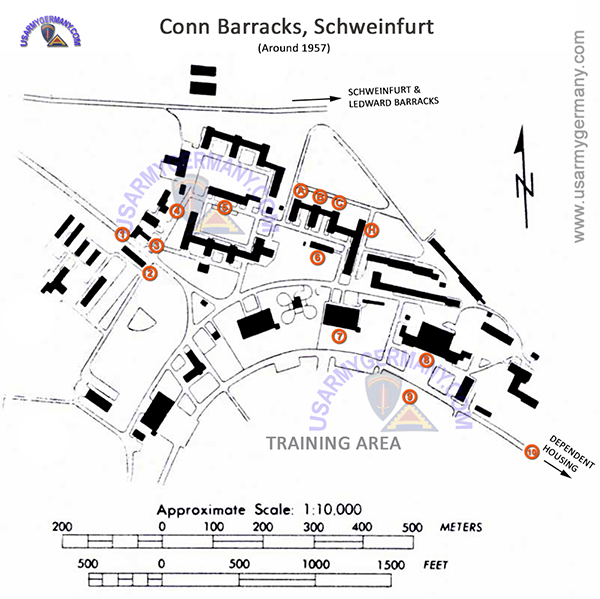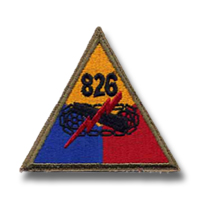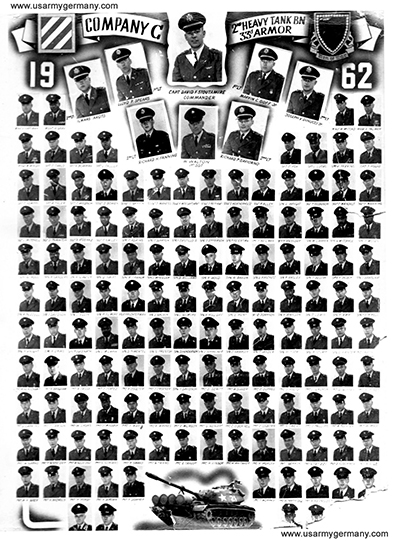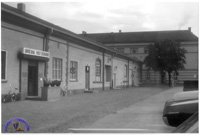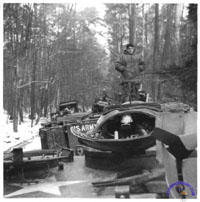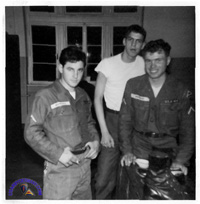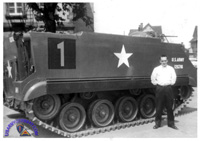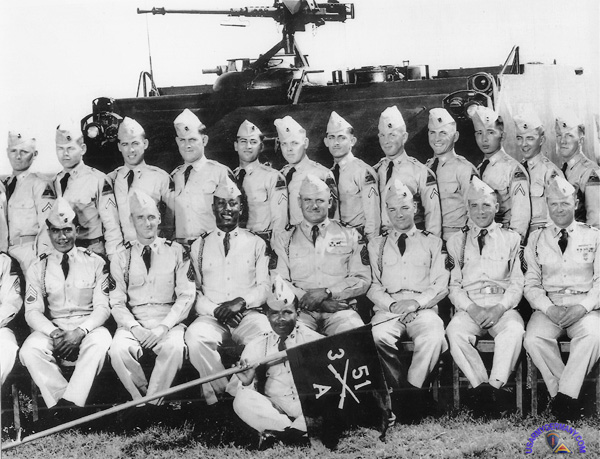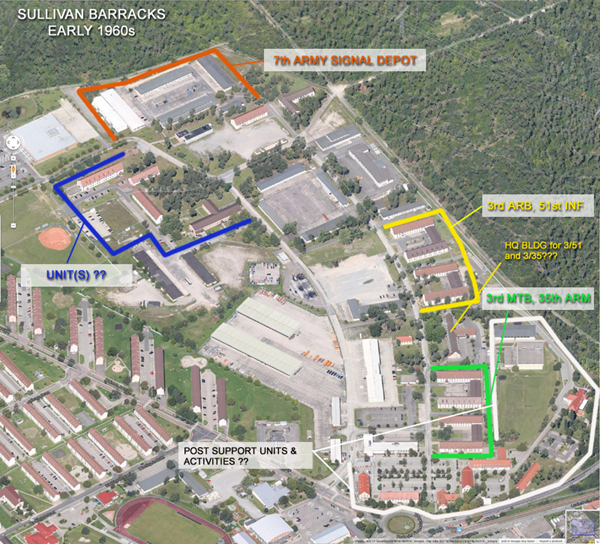| If you do
NOT see the Table of Contents frame to the left of this page, then
Click here to open 'USArmyGermany' frameset |
|||||||||||||||||||||||||||||||||||||||||||||
4th Armor Group |
|||||||||||||||||||||||||||||||||||||||||||||
|
|||||||||||||||||||||||||||||||||||||||||||||
|
|
|||||||||||||||||||||||||||||||||||||||||||||
 |
|||||||||||||||||||||||||||||||||||||||||||||
| Group History | |||||||||||||||||||||||||||||||||||||||||||||
| 1955 - 1963 | |||||||||||||||||||||||||||||||||||||||||||||
| (Source: Unit History, submitted by Gordon Allen) | |||||||||||||||||||||||||||||||||||||||||||||
| On 1 May 1946, the Fourth Cavalry Group (part of the Army of Occupation in the European Theater) was integrated into the United States Constabulary as the 4th Constabulary Regiment, consisting of the 4th, 16th and 24th Squadrons. (The 16th Sq was not originally part of the 4th Cav Gp - it was attached on 1 May 1946.) On 1 April 1949, the 4th Con Squadron was relieved from its assignment to the Constabulary and was redesignated the 4th Reconnaissance Battalion, and stationed at Camp Truscott, and later moved to Camp McCauley, Austria. On 1 Dec 1951, the unit was redesignated as the 4th Armored Cavalry Reconnaissance Battalion. (On 3 March 1955, Headquarters and Headquarters Company, 4th Armored Cavalry Regiment and 24th Reconnaissance Battalion consolidated into the 4th Armd Cav Recon Bn.) The 4th remained in Austria as part of the forces of United States Forces Austria until 24 June 1955 when it was reassigned to Headquarters, USAREUR. On 30 June 1955, the 4th Armd Cav Recon Bn was inactivated. On 1 July 1955, the 19th Armor Group was redesignated the 4th Armor Group inheriting the history of the 4th Cavalry Regiment and all of its elements. The 4th has been stationed in Frankfurt, Germany since 1955 and is considered by General Clarke, Commanding General, Seventh Army to be his sixth division. Home station is at Gibbs Barracks, Frankfurt and the present (1957) commanding officer is Col Arthur M. Murray. He assumed command of the unit in Nov 1956. |
|||||||||||||||||||||||||||||||||||||||||||||
| (Source: Seventh Army Composition, June 1956, 7th Army Annual History, 1956) | |||||||||||||||||||||||||||||||||||||||||||||
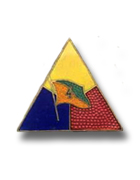 4th Armor Group DI
4th Armor Group DI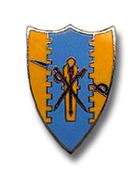 Did the 4th Armor Group wear the 4th Armd Cav crest before the new
one was authorized?
Did the 4th Armor Group wear the 4th Armd Cav crest before the new
one was authorized?Units attached to the 4th Armor in Group in June 1956: |
|||||||||||||||||||||||||||||||||||||||||||||
|
|||||||||||||||||||||||||||||||||||||||||||||
| [1] Northern Area Command Telephone Directory, effective 15 February 1956, Signal Corps. | |||||||||||||||||||||||||||||||||||||||||||||
| [2] STATION LIST, 17 April 1957 | |||||||||||||||||||||||||||||||||||||||||||||
| [5] It appears
that the 826th returned to the States (Fort Benning, GA) in November
1956. Can anybody confirm this? (Source: Buz Bresciani - The 826th Tk Bn had an advance party return to Fort Benning in 1956 but the total battalion Gyroed in 1957 from Schweinfurt to Fort Benning, Ga. I was the S2 Sgt for the Bn.) |
|||||||||||||||||||||||||||||||||||||||||||||
| (Source: Seventh Army Composition, June 1958, 7th Army Annual History, 1958) | |||||||||||||||||||||||||||||||||||||||||||||
| Units attached to the 4th Armor in Group in June 1958: | |||||||||||||||||||||||||||||||||||||||||||||
|
|||||||||||||||||||||||||||||||||||||||||||||
| [3] STATION LIST, 16 April 1962. | |||||||||||||||||||||||||||||||||||||||||||||
| [4] The 899th Tank Bn was inactivated on 1 May 1958 in Germany; concurrently, personnel and equipment were transferred in place to the newly activated 2nd Heavy Tank Bn, 33rd Armored which was activated on the same day and assigned to USAREUR. | |||||||||||||||||||||||||||||||||||||||||||||
| Webmaster Note: My records also show that the the 4th Armor Group was inactivated on 1 April, 1963, in Germany. | |||||||||||||||||||||||||||||||||||||||||||||
|
|
|||||||||||||||||||||||||||||||||||||||||||||
|
|||||||||||||||||||||||||||||||||||||||||||||
| (Source: Email fron Al Kreilick, 826th Tank Bn at Schweinfurt) | |||||||||||||||||||||||||||||||||||||||||||||
| The 714th
Tank Bn was a gyroscope unit from Ft. Benning and in late
1956 swapped places with the 826th Tank Bn
at Schweinfurt. Later the 714th was redesignated 3rd Bn, 37th Armor
at Fliegerhorst Kaserne, Schweinfurt. Both 826th and the 714th were a part of the 4th Armor Group. I was in the 714th from March 1956 until December 1959. Al Kreilick |
|||||||||||||||||||||||||||||||||||||||||||||
| 1958 | |||||||||||||||||||||||||||||||||||||||||||||
| (Source: Email from Gerald Stewart) | |||||||||||||||||||||||||||||||||||||||||||||
| Attached to
this note is four-page Word document in which I discuss my remembrances
of 4th Armor Group during the second half of 1958 and all of 1959.
Fortunately, my mother saved my letters from Germany and gave them
to me before she died. Unfortunately, the cache included very few
letters for 1959. Most of the information included in the document
is based solely on details reported in the letters. I arrived in Germany as a Private and left as a Specialist 3. So, the point of view is that of one of the troops, not that of military expert or historian concerned with broader events. It is the view from below. The remembrances intend to describe briefly what life was like at Headquarters, on the post, and in the field. We at Gibbs lived quite comfortably, of course, compared with our friends in the battalions who did the real work. I focussed on details reported in the letters -- those of routine a nature. What were the buildings like? What was daily living like? What facilities were provided? I mention a few of those with whom I served but mostly withhold comment on their personalities. I thought that would be inappropriate. |
|||||||||||||||||||||||||||||||||||||||||||||
|
Remembrances
of 4th Armor Group: 1958-1959 |
|||||||||||||||||||||||||||||||||||||||||||||
|
|
|||||||||||||||||||||||||||||||||||||||||||||
| 1961 | |||||||||||||||||||||||||||||||||||||||||||||
| (Source: STARS & STRIPES, Dec 13, 1961) | |||||||||||||||||||||||||||||||||||||||||||||
| All five battalions of the 4th Armor Group came together at Grafenwoehr for a large mounted review to mark the Armor branch's anniversary. This was the first time since 1955 that all subordinate units of the widely dispersed armor group had been assembled in the same place at the same time. Participating in the review were the following 4th Armor Group units: |
|||||||||||||||||||||||||||||||||||||||||||||
| If anybody has
additional information on the history or organization of the 4th Armor
Group, please contact me |
|||||||||||||||||||||||||||||||||||||||||||||
| 1962 | |||||||||||||||||||||||||||||||||||||||||||||
| (Source: Email from Dale Snook) | |||||||||||||||||||||||||||||||||||||||||||||
| I served in the
4th Armored Group from summer of 1962
until deactivation in April 1, 1963. We were the headquarters company for the first multi-national NATO exercise near Thessaloniki, Greece, from 4 Oct to 18 Oct 1962. John G Wheelock the III was our commander. I also served in the 51st Inf in Mannheim prior to to going TDY to Frankfurt and then being reassigned there. Sgt Maj Joseph Veneable, died later in Viet Nam. Lt Col Williams spoke at a ceremony at the Vietnam Wall, he was a Lt General at the time. I have very little knowledge of what happened to the others. I do have memories and letters that I wrote at the time. I am currently a Veterans Rep in California so my mind goes back to that time constantly. When we deactivated we had only three battalions left: |
|||||||||||||||||||||||||||||||||||||||||||||
|
|
|||||||||||||||||||||||||||||||||||||||||||||
| 510th Tank Battalion / 3rd Med Tk Bn, 35th Armor | |||||||||||||||||||||||||||||||||||||||||||||
| 19.. - 1955 (510th Tk Bn, 19th Armor Gp) | |||||||||||||||||||||||||||||||||||||||||||||
| 1955 - 1958 (510th Tk Bn, 4th Armor Gp) | |||||||||||||||||||||||||||||||||||||||||||||
| (Source: Email from Jack Blanchard, 510th Tank Battalion Assoc. President) | |||||||||||||||||||||||||||||||||||||||||||||
| I would like to set the record straight. The 510th Tank Battalion became the 35th Armor in the summer of 1958. The 510th of the 4th Armor Group won the best tank battalion in Europe in 1957 under the command of Col. Borderly. The 35th Armor took over for the 510th Tank Battalion in the summer of 1958 and was sent to Lebanon. This mission was brought about by President Ike. The United States was showing support for the ruling goverment at that period. Currently I am trying to get more accurate information through the Department of Army. The historical division at Carlisle, PA is relocating on post to a new location. The move will be completed on Aug. 2, 2004. Any futher information you might have would be helpful. I have friends who served through this transition and myself left the 510th in Jan. 1958. |
|||||||||||||||||||||||||||||||||||||||||||||
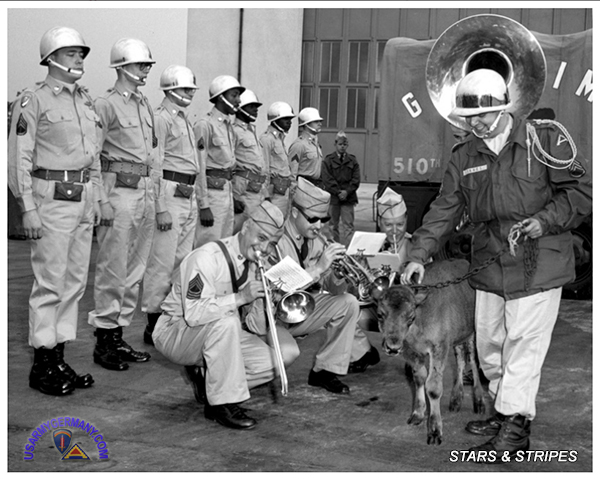 "Geronimo," the new buffalo recruit of the 510th Tank Battalion ("Fighting Buffaloes"). The unit mascot was a gift to the battalion by the Lehigh County, Pa., game preserve and joined the battalion in August 1954. |
|||||||||||||||||||||||||||||||||||||||||||||
| (Source: Email from Michael James Morton, son of M/SGT James "Jimmie" D. Morton) | |||||||||||||||||||||||||||||||||||||||||||||
|
|||||||||||||||||||||||||||||||||||||||||||||
| ADDITIONAL INFORMATION: From 06 Jan 1958 until 01 Sep 1961 - 1st Lt, and, later, Captain Jimmie D. Morton served in Mannheim Germany as an Armor Officer to include holding assignments as Liaison Officer, Tank Unit Commander, Asst Adjutant 4th Armor Group, Co "B" Executive Officer, Commander Company "B", Commander HQ Company, and, later Battalion Adjutant for the 510th Heavy Tank Battalion [redesignated 3rd Medium Tank Battalion of the 35th Armor]. On 20 Oct 1950 the 10th Cavalry Regiment [i.e., one of the original Buffalo Soldiers outfits] was removed from the 2nd Cavalry Division and its Regimental History and Regimental Colors were redesignated to the 510th Heavy Tank Battalion. Shortly after 12 Aug 61 all of Mannheim's Sullivan Barrack's tanks were mobilized and sent via the autobahn to Berlin (i.e., the East Germans built the "Berlin Wall") Also, shortly thereafter, Jimmie, his wife and his two sons were reassigned to quarters in Kentucky). Jimmie served at Ft. Knox [Home of the Armor School] from late 1961 until late 1964. |
|||||||||||||||||||||||||||||||||||||||||||||
| 1958 - 1963 (3rd MTB, 35th Arm, 4th Armor Gp) | |||||||||||||||||||||||||||||||||||||||||||||
| (Source: Email from Richard L. Morgan) | |||||||||||||||||||||||||||||||||||||||||||||
| I left Brooklyn Army Terminal on the USNS Geiger troopship in July 1961. It was old even then. The crossing was uneventful until we reached the English Channel when we hit one of the worst storms of the century. The ships propellers were completely out of the water when we went over the crest of the waves. The entire ship shuddered when the propellers dug into the water at the bottom of the wave. This went on for about 24 hours. If I hadn't been so young and dumb, I would have been more scared. When I think about it now, I get chills. The ship docked at Bremerhaven where I boarded a train for Mannheim, Germany. I was assigned to the (3rd Med Tank Bn,) 35th Armored, 4th Armor Group, at Sullivan Barracks. I joined the Finance Section of the personnel office for which I had been trained at the Finance Center in Indianapolis, IN. Two weeks after I arrived, the Berlin Crisis occurred which resulted in the building of the Berlin Wall. We were on 24 hour alert for about a month until things cooled down. For a time, war appeared imminent. At the time, I thought, "I just got here, and they have to start a war. I thought this was a peacetime duty". Some details of the time. 1 German Mark = 25 American Cents. 15 cents for a bier. 25 cents for a shot of Cognac. Cognac was the preferred hard liquor. Steinhager was the most potent drink. Some guys went temporarily nuts after drinking too much. Girls drank either bier or Cognac with Coke. I started out at $78 per month as a recruit. I finished with $180 per month with Proficiency Pay in 1964 when I got out. Off-base segregation was still a fact of life. There were Black bars and White bars. Only on-base was there integration. I had my first experience with prejudice because of color since I was a naive kid from rural Montana. There were race riots that occurred on post which were basically covered up by the brass. To this day, only the ones who were there remember. Any documentation is buried in the archives or never written. The only names that I remember from the 35th Armor were Bernie Plouffe, Company Clerk from Polson, Montana and Jim Baskett from Louisville, Kentucky. The main focus for us young kids was to drink and find girls. It took a few months to get used to the strong German bier, and even longer to communicate with German girls who couldn't speak English. There were no American girls because this was a period of time when dependents weren't allowed. The guys who had the best time were the World War II vets who were stationed without their wives, could speak the language, and knew women from their previous tours. Plus they were in the higher ranks and had more money than us peons. There was a midnight curfew for all Army personnel. Everyone had to be off the streets and in the barracks before midnight every night, including weekends, even if you had a weekend pass or were on leave. This created some interesting situations in the bars between Army and Air Force personnel. Air Force didn't have a curfew. The Army guy would buy drinks for a girl all night until time to go. Air Force would move in sometimes before the Army guy left. The resultant donnybrook created a lot of animosity between Army and Air Force. Alerts were held every month, always in the middle of the night. Duty was basically eight hours a day, five days a week. There was guard duty about once every two months. I think KP was performed by local Germans. First thing in the morning was the coin flip to see who would go to the local sandwich kiosk to get bologna sandwiches and cokes to subdue the previous night's hangover. Few went to breakfast after the first few months. The smell was not conducive to an upset stomach from too many biers the night before. Weekends were spent exploring the areas around Mannheim, Viernheim, and Heidelberg. Heidelberg had some great jazz clubs. Viernheim had the closest bars to the post. Field training occurred in Grafenwoehr on the Czechoslovakian border twice a year. The artillery fired rounds over our area into an impact area near the post. There were tales of short rounds killing some bivouaced soldiers in previous years. I will never forget the sight of rounds flying overhead through the clouds while I walked a guard post. Bier and wine festivals were especially appealing. One festival was held yearly in Bad Durkheim, the home of the biggest wine barrel in the world. It originally held 1,700,000 liters of wine. It had been converted into a bar which was big enough to have an upstairs balcony which ran around the full circumference of the barrel. The festival had 5 Bier Tents, each with a band, and 14 wine tasting tents from the local vineyards, and carnival rides. The ferris wheel was too much for some of my buddies who emptied their stomachs after too much bier and wine. It was impossible for us GI's to outdrink the local Germans. Most of the GIs were either passed out or crawling around on hands and knees while the Germans were still drinking, singing, and dancing far into the night. It was one time when a curfew was probably to our advantage, or we would never have made it back to the barracks. During the Berlin Crisis, all personnel who had been scheduled for rotation back to the U.S. had their tours extended. Some were pulled off of the ships and trains and sent back to their units. This resulted in some drastic mental problems for some of those who expected to be home. Drinking increased, and some whose records had been clean, ended up with Article 15's or court martial because of acting out over their retention in the service. On the up side, the following field exercises resulted in new records being set in all areas of efficiency and competency in the armored corps because most of these men had been training together for up to 3 years and longer. Probably the best tank corps, especially drivers, since World War II. They could park those steel machines on a dime and in formation. In the spring of 1962, I was called to Headquarters, 4th Armor Group, in Frankfurt to interview for a personnel position available because of the rotation of a soldier back to the States for discharge. I was transferred to Frankfurt into the Headquarters Company. I and Ron Percival processed all personnel and finance actions for the Group Headquarters. These included monthly payroll, 201 file actions, and officer efficiency reports. All of this was done either by hand or on manual typewriters. Days were long, but Frankfurt was a great town for off-duty. Trolleys went to every part of the city for just a few cents. Full-body strip clubs were everywhere downtown. One of the best places was an old-time German bar with an oompah-pah band called the Maiergustle. Waitresses in peasant blouses and skirts served the steins. Every night was packed. Some of the waitresses could carry multiple steins at a time, and if anyone got fresh, they might get their block knocked off. These women were strong! At the same time, the curfew restrictions were finally loosened after a change of generals. Dependents were allowed to come to Europe which inhibited some of the fun times for the married guys, but provided some American girls, teachers, etc., where there had been none before. There was an area called the Crooked Mile which was entirely GI bars and restaurants. B-girls could be found in places like the New York City Bar. Only the officers could afford to go to those places where the drinks were exorbitantly priced, and the girls got paid by how many drinks they could get a guy to order and drink. They kept track with swizzle sticks which they turned in at the end of the shift. The bars were open for 24 hours except for an hour in the morning to clean up. There was no drinking age limit except for a few which only posted it to keep out the German kids. GI's were never carded. Wurst stands were everywhere. I became an aficionado of currywurst -- Sausages smothered in Curry Sauce on a bun. I can taste them to this day. Every kind of chocolate could be found in small stands around the city. The only fellow GI's names that I remember from that time were, Ron Percival from Seattle, John Vradenberg from San Fernando Valley, California, Lieutenant Pulce from Pennsylvania, Sgt. Maj. Venable (who died in Vietnam), Major Sjorup, Shinos, a Cree Indian from Ontario, Canada, and Harry Player from Chicago. John G. Wheelock III was the commanding Colonel. At that time he was the youngest Colonel in the military. He was a graduate of West Point and marched a unit to one of the Atomic bomb tests conducted with troops within a mile of the blast in Nevada. He was considered to be on the fast track to be General. He was a favorite of the V Corps commander, Lt. Gen. Michaelis, who was a decorated World War II and Korean veteran. Gibbs Barracks was a small post which we shared with an engineer battalion. There was an EM club, a softball field/parade ground, and gymnasium. Our unit didn't pull guard duty. All of the food service was performed by GI cooks and German civilians, no KP for us! We received very little news except from the Stars & Stripes. The only U.S. newspapers were those packed in Care packages from home. As a result, I didn't even know how serious the Cuban Missile Crisis was until after I read the history when I got out of the service. During the crisis, we were in the field in Grafenwoehr. All practice alerts were cancelled, and if an alert was called, it would be the "Red" one. Some idiot General at 7th Army called one anyway. The Colonel's driver came running through headquarters like he was possessed and white as a sheet. An alert had been called which he thought was the "Big" one. It finally got straightened out after some ass-chewing from the Colonel to his higher-ups. I think now how easy it would have been to start a war, probably nuclear, by some nut-case in the wrong position. Frankfurt offered many opportunities for recreation including the huge EM club at Rhein-Main Air Force Base where the best musical groups performed on arrival from the States, including The Four Freshmen and Ella Fitzgerald. In addition to local recreation, the great train system of Germany allowed one to go almost anywhere easily. Garmisch was the official recreation area located in the southern German Alps on the Swiss/Italian borders. Spectacular scenery, but expensive for enlisted personnel. T This year was the best of my tour in the Army. Unfortunately, the 4th Armor Group was disbanded in 1963 which usually occurred on a regular basis because there had to be something for the Pentagon brass to do when there wasn't a war going on. Turning personnel's life upside down was the only result of the constant reorganization; it sure as hell didn't improve the capabilities of the units. In fact, it usually took about a year for the new units to perform effectively. None of the units into which I was transferred ever had the esprit de corps and comradery contained in any of the 4th Armor Group units. Now that the wall is gone, Germany is united, and the U.S. military forces reduced, all of this fades into the mists of time. Those times can never be experienced again. SP4 RICHARD L. MORGAN |
|||||||||||||||||||||||||||||||||||||||||||||
| 714th Tank Battalion / 3rd Med Tk Bn, 37th Armor (see 4th Armored Division Page) | |||||||||||||||||||||||||||||||||||||||||||||
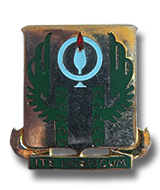 714th Tank Bn DUI 714th Tank Bn DUI |
|||||||||||||||||||||||||||||||||||||||||||||
| 1956 | |||||||||||||||||||||||||||||||||||||||||||||
| (Source: Email from Jim Bly) | |||||||||||||||||||||||||||||||||||||||||||||
| I was in the 714th Tank Battalion from 3/1956 until 12/1959. I went over on the USNS Morris Rose and returned on the USNS Gen Buckner. I am submitting some pics (see above) I took when the 714th Tank Bn hangar caught fire. A careless welder burned through a gas tank when they where installing the external gas barrels. Good thing all the ammo was removed before the tanks went in the hanger. I was discharged at Ft. Dix, NJ. |
|||||||||||||||||||||||||||||||||||||||||||||
| (Source: Email from Al Kreilick) | |||||||||||||||||||||||||||||||||||||||||||||
| The 714th Tank Bn was a Gyroscope unit from Ft. Benning and in late 1956 swapped places with the 826th Tank Bn. at Schweinfurt. Later 714th was redesignated as 3rd Bn, 37th Armor at Fliegerhorst Kaserne, Schweinfurt. Both 826th and the 714th were a part of the 4th Armor Group. I was in 714th from March 1956 until December 1959. |
|||||||||||||||||||||||||||||||||||||||||||||
| 1956 | |||||||||||||||||||||||||||||||||||||||||||||
| (Source: Email from Curtis Banker) | |||||||||||||||||||||||||||||||||||||||||||||
| I was assigned to A Company, 714th Tank Bn in Fort Benning, GA. in 1956 and rotated with the unit to Schweinfurt, Germany, Conn Barracks. We were allowed to have our family accompany us and occupied brand new Appartments. The post was located where the Germans had an airfield during the War. They said that there were Atomic Cannons there also, but they were top secret. We did not know where they were located. The Battalion changed to the (3rd MTB, ) 37th Armor during my tour. We ran the Tank Firing Ranges at Bergen-Belsen Training Area (British sector), one year, for the whole 7th Army. I have located two friends that were in A Company and live in Columbus, GA.: 1st Sgt. Black and Bobby Hill. It has been a long time but I pretty well remember the layout of the Conn Barracks and housing area. I remember the mess hall, HQ Building and the barracks as well as the motor pool, NCO Club, and converted aircraft hangar that was used for maintenance and USO Cafeteria combination. The hangar used by Bn S-4, was used for storing supply items, mostly sheets, laundry, etc. for the Battalion. They supplied the individual Companies. I don't remember any other activities at the Education Center Building. I enrolled there to take classes in Ballistics, but there were no other enrollments so
the class was deleted. |
|||||||||||||||||||||||||||||||||||||||||||||
| 1957 | |||||||||||||||||||||||||||||||||||||||||||||
| (Source: Email from Lonnie Kiefer) | |||||||||||||||||||||||||||||||||||||||||||||
| The 714th Tank Battalion arrived in Conn Barracks Schweinfurt Germany in March of 1957 and was part of 4th Armor Group. We also had a sister Armored Infantry Battalion in Wildflecken Germany. I came over with the 714th from Fort Benning, GA and joined the 510th when they went to Lebanon in 1958. We later became the 35th Armor. (Webmaster note: a comment made by Buz Bresciani, indicates that the swap (Gyroscope) between the 826th Tank Bn at Conn Barracks and the 714th Tank Bn at Fort Benning, Ga. did indeed occur early 1957.) |
|||||||||||||||||||||||||||||||||||||||||||||
| 746th Armored Infantry Battalion | |||||||||||||||||||||||||||||||||||||||||||||
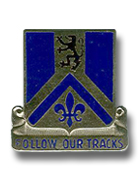 746th Armored Infantry Bn DUI 746th Armored Infantry Bn DUI |
|||||||||||||||||||||||||||||||||||||||||||||
| 1956 | |||||||||||||||||||||||||||||||||||||||||||||
| (Source: STARS & STRIPES, April 28, 1956) | |||||||||||||||||||||||||||||||||||||||||||||
| The 746th Armd Inf Bn, commanded by Lt Col Edward M. Ghiz, has officially become part of the 4th Armor Gp. The unit was activated here on Oct. 24, 1955, after 10 years of inactivity and had been attached to the 2d Armd Div until this reassignment. The 746th is stationed in Worms. |
|||||||||||||||||||||||||||||||||||||||||||||
| (Source: Email from David Sizemore) | |||||||||||||||||||||||||||||||||||||||||||||
| I was in Bamberg, Germany with the First Division (Big Red One) until they moved to Fort Riley. This was in the winter of 1955-1956. I along with several other's were transferred to Worms, Germany to the unit (746th AIB). We wore a patch called THE SEVEN STEPS TO HELL (Seventh Army Patch). The Unit was located in old Barracks' (Foch Kaserne later redesignated as Taukkunen Barracks) which had a tall fence completely around the Base with a NCO Club located across the Street from the main gate also had a gym across the street. If my memory serves me right this was a "Bastard Battalion." I have pictures ect. of the Old Church located in Worms and of other buddies that were there with me. My driver's name was Mort Roberson from upstate New York, do not recall the name of the town. But he named his first born Boy after me and was the best driver in the unit. If you wish I will dig out the old pictures ect. |
|||||||||||||||||||||||||||||||||||||||||||||
| 826th Tank Battalion | |||||||||||||||||||||||||||||||||||||||||||||
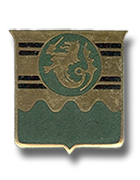 826th Tank Battalion DUI 826th Tank Battalion DUI |
|||||||||||||||||||||||||||||||||||||||||||||
| (Source: Email from Ralph Midcalf, 826th Tank Bn) | |||||||||||||||||||||||||||||||||||||||||||||
|
|||||||||||||||||||||||||||||||||||||||||||||
| (Source: Email from Bruce Davis, 826th Tank Bn) | |||||||||||||||||||||||||||||||||||||||||||||
| Walter, Got your message to Norm Jackson re the 826 TK Bn and from messages I have since received assumed you have the answer you were looking for already. I joined the 322nd in 1954 and gyroscoped with it as the 826th Tank Bn to Ft Benning Ga in 1957. Was with that unit until it deactivated in Gerogia at which time I was assigned to 2/69, the Bn assigned to 2d Inf Div, and stayed with it till retirement May 62. Are you aware that 826th Tank Bn was organized as a (120mm) gun battalion and had that appendage on their designation. We had 22 tanks per company and 4 companies with 3 tanks in Bn headquarters for a total of 91. Thats a lot of road space. |
|||||||||||||||||||||||||||||||||||||||||||||
| 1955 | |||||||||||||||||||||||||||||||||||||||||||||
| (Source: Email from James B. Woody, 826th Tank Bn, 1955-56) | |||||||||||||||||||||||||||||||||||||||||||||
| I was in the 826th Tank Bn at Hammelburg from Jan 1955 to about May or June 1956, at which time the unit was moved to Schweinfurt. The post at Lager Hammelburg was then turned over to the newly created Bundeswehr. I was one of the last to leave Hammelburg and was present when many of the Germans started occupying Camp Clark. We were impressed with the enthusiasm all these men had for the military life . . . all of them looked to be of the age to have been WW II veterans. They ran and sang everywhere!! That post on a hill overlooking the old town of Hammelburg had been a German training base before the war and, as is generally known, was also a POW camp during the war. Serbs spent almost 4 years there and they helped the Americans brought there as prisoners from the Battle of the Bulge. I mustered out in August 1956 so do not know what became of the unit at Schweinfurt. We do remember that Bad Kissingen was a good spot for free time during the 50's. One of my friends from that time, Al Falchi, runs a prominant restaurant in San Fransisco, which was visited by Bill Clinton when he was President. Another pal, Jim Reisner, went on to be a OB-GYN doctor out in Washington State; Gaylord Brooks was a civic official in Cumberland, Maryland, and Pete Merrill went into the hotel business in Naples, Florida. We were in the Medical detachment operating out of the Dispensary at Camp Clarke, and our Commanding officer was Mel Scharfman MD, a drafted New Yorker. Many fond memories of our time "on the hill" overlooking Hammelburg. |
|||||||||||||||||||||||||||||||||||||||||||||
| (Source: Email from David Tilford) | |||||||||||||||||||||||||||||||||||||||||||||
| I was happy to see that the 826th Tank Bn still lives on, if only in memory. I was there, in A Company, from Feb 1955 till Sept 1956. Just a short time but was one of the best, I was 18-19 at the time. Got hurt and was sent to Frankfurt Army Hospital then was sent home to Ft Devens and was let go there in 1957. Most of what I rember are some of my crew members: my TC's name was Sgt Shicksnider; I was the driver; James Cossett was the gunner and Rodger Willamson was the loader. We had the M-48's -- hell of a tank. The billets were I stayed were across from the ordely room. The thing that stands out in my mind were the floors ... they really shined. Do you rember where the tank pool was? Well as I had spent a lot of time down there, I had plenty of time to check out the horse stables that I think may have been used as a holding place for the DPs. Anyway, seems as all the support beams had holes in them. So I took a stick adn was poking in them -- most were full of horse hair. But one held a wounderful find. It was two hand-drawn pictures and a flag that was made from bit of cloth. It was red, white and blue with a 1/4 moon at the head of it . Never looked to see what country it was from. Don't mind me, I think of things later and want to tell you about them. My CO's name was Lt Blankership and we had a 2nd louie, named Smith. I had a friend who's name was William Horner. He lived in Strawberry Plains, Tn. But I never got in touch with him. You know that sometimes people move on or die, and I always felt that I would bring up memories for the family. Well, I hope you find some of what I told you to be helpful to you. |
|||||||||||||||||||||||||||||||||||||||||||||
| 1956 | |||||||||||||||||||||||||||||||||||||||||||||
| (Source: Email from LeVoy Davies Francisco, son of Lt Col Walter J. Davies, former CO of the 826th Tank Bn) | |||||||||||||||||||||||||||||||||||||||||||||
| Today for some reason I decided to look up the 826th Tank Battalion. My father, Lt Col Walter J Davies, was the commander during those years. I was ten years old. I enjoyed reading the bits provided by those who served in the 826th. My dad really enjoyed that assignment. I remember that the first time the American flag and the New German Army flag flew together was at Hammelburg just before the 826th moved to Schweinfurt. From what I remember, the 826th participated in the only Gyroscope ever conducted. Boy, did the folks at Ft Benning (Georgia) dislike Armor! Dad retired as a Colonel. He died on March 11, 2011 at the age of 92 in Bel Air, MD. He and Mom were married for 70 years. I hope those who served with him remember his as fondly as he remember reed them. As mentioned, I was there as a dependent. I really don't know where most of the dependent families lived in or around Hammelburg. We lived in requisitioned housing, and moved as the houses were returned. The first one had been owned by "the salt and pepper king of Germany", the person who had a monopoly on salt and pepper at the time. It was on Rosen Strasse, high up on a hill with terraced grounds surrounded by fruit trees. A gardener was provided. When the 826th left Hammelburg and moved to Schweinfurt (around June 1956) we moved into another house on the economy. It was a little less grand than the other two had been. It was built into a hill and from the road you drove directly into the driveway and the garage. To get to the front door you had to go down steps and around a corner. There were fruit trees terraced there too. When that house was returned to the Germans we moved on post into a newly constructed duplex. In all cases our furnishings were provided by Quartermaster. There was more than one grade in each classroom at school. The classes were small. We had a class in German each week, but I don't think that I learned much. I can still ask where the train station is though. Of course from the perspective of a kid the fact that Elvis was stationed at Schweinfurt (sic) when we lived there was a big deal. I think we attended the same Saturday matinee at the movie theater once. I have been thinking about the flags flying at the change of command ceremony... it must have been the American flag and the new German flag. I wish I had known about your site before my dad died. He would have been able to share so much valuable information. I will let my brother know. Maybe he would remember things which didn't interest me at the time. Thank you for your interest in the 826th. The tanks were so impressive! I got to ride in one once. The noise was loud, and the ride was rough but it was one of the coolest things I ever did. The 826th was special. There is another area to be explored for the sake of history...that of the role of the officer's wife. It was a very different world. |
|||||||||||||||||||||||||||||||||||||||||||||
| 899th Tank Battalion / 2nd Hvy Tk Bn, 33rd Armor | |||||||||||||||||||||||||||||||||||||||||||||
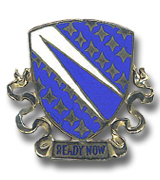 899th Tank Battalion DI 899th Tank Battalion DI |
|||||||||||||||||||||||||||||||||||||||||||||
| (Source: Email from Clarence "Bucky" Walters, 899th Tank Bn) | |||||||||||||||||||||||||||||||||||||||||||||
| I served with the 899th Tank Battalion from March, 1955 until November 1956. When I arrived I was assigned to Company A as a Tank Platoon Leader. When we changed from the M-47 to the M-48 tanks we changed the organizational structure of the Battalion to a heavy tank organization. This restructuring moved from three companies with four platoons each to four companies with three platoons each. When the fourth company was added I was moved to it as one of the three platoon leaders. I later became the company executive officer. Captain Raymond McEachin was the company commander. At the time Major Waite was the Battalion Commander. He had replaced Colonel Hewitt who was the commander when I joined the 899th in March, 1955. I have been disappointed to see very little about the 899th in the commentary about the other units in the 4th Armored Group. One historical note about the 899th was that Captain Alexander Haig joined the Battalion as S-3 in 1956. I left the Battalion in November, 1956 the week the Russians invaded in Hungary. One of the members of the Battalion I have remained in contact with is Gerry Smith who was a company commander until he left the unit and then reverted to his enlisted rank. He now lives in Kansas. I hope this brief info about the 899th may generate more comments from others who served with the Battalion. |
|||||||||||||||||||||||||||||||||||||||||||||
| 1962 | |||||||||||||||||||||||||||||||||||||||||||||
| 1st Armd Rifle Bn, 48th Inf | |||||||||||||||||||||||||||||||||||||||||||||
| 1961 | |||||||||||||||||||||||||||||||||||||||||||||
| (Source: Email from Frank Falcone (Ralph Midcalf), 1st ARB, 48th Inf then 1st Bn, 39th Inf) | |||||||||||||||||||||||||||||||||||||||||||||
| My name is Jack Falcone. In the Army I was Jack Lapiana, stationed at Taukkunen Barracks in Worms from Dec. 1961 until July 1964. I was attached to the 48th Infantry (Webmaster note: 1st ARB, 48th Inf) 7th Army and then we changed over to the 1/39th, 8th ID. I remember training as a LRRP (Long Range Reconnaissance) and a general telling us that we were LRRP's now. But the 1/39 8th ID is never mentioned in any writings on LRRP training. Do you have any knowledge of where I can gather info on that training and any info on when our battalion was included in the training of lrrp's? It's as if we never existed. I spent 2 1/2 years in Germany. As infantrymen we rode in the APC's then they trained us in jumping from Iroquois helicopters. After one year in training, in 1963, we became LRRP's and then we became airborne rangers. I was one of the men issued an M-79 and I was happy because I got to carry a 45 and no more rifle. I left in July 1964 to serve in the reserves for another 3 years. |
|||||||||||||||||||||||||||||||||||||||||||||
|
|||||||||||||||||||||||||||||||||||||||||||||
| 3rd Armd Rifle Bn, 51st Inf | |||||||||||||||||||||||||||||||||||||||||||||
| 1958 | |||||||||||||||||||||||||||||||||||||||||||||
| (Source: Email from David Stanley) | |||||||||||||||||||||||||||||||||||||||||||||
| Attached you will find a photo of my Father MSgt. William J. (Bill) Stanley with Company A, 3rd Armored Rifle Battalion, 51st Inf., APO 39. He is the Big man sitting center (MSgt stripes) behind the unit guidon.
My family was stationed in Germany from 1958 – 1960. My father served from 1941 to 1960. He was a combat vet in WWII and Korea. |
|||||||||||||||||||||||||||||||||||||||||||||
| 1961 | |||||||||||||||||||||||||||||||||||||||||||||
| (Source: Email from Grayal Earle Farr) | |||||||||||||||||||||||||||||||||||||||||||||
| I was assigned to the 4th Armor Group in February, 1962, after completion of Advanced Infantry Training at Fort Dix. On arriving in Germany I joined 3/51st Armored Rifle Battalion (ARB), which some told the folks at home meant “airborne ranger battalion.” I was assigned to the Scout Platoon. There were two other battalions in the group at the time, an armor battalion (maybe of the 40th?) also based, as was 3/51st, at Sullivan Barracks in Mannheim, and a battalion of the 48th Infantry (for sure), based in Worms. (Webmaster note: a review of the STATION LIST for June 1962 shows the following units still attached to the 4th Armor Group: An interesting side note: the Heavy Tank Battalion (2nd Bn, 33rd Armd) formerly attached to the 4th Armor Group has been split into the four independent companies with two (B & D Companies) attached to the 3rd Armored Division and the other two (A & C Companies) to the 3rd Infantry Division. HHC of the HTB seems to have been inactivated.) It was a very different Army from the one I retired from in 1994. Nobody did PT. Not even the Scout Platoon. Maintenance was a joke. Paint and polish, even on tactical vehicles, was the big thing. Good story: The tank battalion had an extra, off the books -- tank. And the M-60s hadn’t been fielded for but a couple of years. They used it as a hangar queen, so it was always just on the verge of inoperability. Came the annual IG inspection they got their worst soldier and told him to take the extra tank and his dirty self out to the Victory Area training woods and not come back ‘till after dark. So he did. But he wasn’t just the dirtiest soldier, he was also the dumbest. He took the tank out towards the ammo dump and backed it into the woods just off the road. Of course, the ammo dump was subject to inspection. The IG team headed for the dump noticed the M-60 with the bumper markings of the battalion they were inspecting parked just off the road. They stopped and after considerable banging the private woke up and opened the hatch. When asked he explained that he’d been told to take the tank out to the woods and not come back ‘till dark. The IG team had him follow them right back to BN HQ. I’d have loved to have been a fly on the wall… In the spring of 1963 the Army was in the throes of reorganizing from the old TOEs (Armored Divisions in three Combat Commands and “Pentomic” Infantry Divisions in five Battle Groups) into the new brigade structure that’s been in use since. 4th AG was dissolved and the battalions experienced extreme makeovers. For starters, the old armor TOEs had four company line battalions. I think the armor battalion and the 48th stayed intact, but restructured. Third 51st was broken up, though I think some companies went intact to become part of new or reorganized formations. Some of us were approached by an 8th MP recruiting team. Had to be a minimum size (I was exactly six feet), no Article 15s, and have at least a year left in theatre. At that time the 8th Division was partly airborne. Under the new TOE it would have an airborne brigade with two infantry battalions and division “slice” element in proportion. As I recall, the division MP companies were also restructured from two-platoon detachments, to five-platoon companies. Which was why they suddenly needed a bunch of extra bodies, school-trained MPs or not. I cared diddle about being an MP, but desperately (no exaggeration) wanted to go airborne. Which I finally managed while in the 8th MPs, remaining with the 5th Platoon of the 8th MPs at lovely Bad Kreuznach ‘till I ETSed in September of 1964. ADDITIONAL INFORMATION I served in the Scout Platoon, 3/51st Armored Rifle Battalion (ARB) February 1962 until the unit was broken up as part of the Reorganization of Army Divisions (ROAD) April 1st, 1963. We were at Sullivan Barracks, Mannheim, along with a tank battalion. There was another ARB, one of the 48th Infantry, at Worms. All three battalions were organized on the old armored (three Combat Commands) TOE. 4th AG was part of V Corps. There were no “slice” units, but I think some were routinely task organized with us from V Corps assets. And BTW, when the warheads for the Davy Crocketts arrived (or somebody decide to start acting as if they had) a Scout Section (four jeeps) stayed loaded and ready in one of the long bays along the lower left edge of the image. On order (which came often) the alert section would run like hell to the bays, mount up, and drive like hell to reinforce the foot guards at an ammo dump out in the “Victory” training area. Maybe the whole platoon pulled the duty and rotated with other scout elements, such as those at Coleman Barracks. AERIAL POTO (GOOGLE) (see above)The long T-shaped building oriented by its long axis towards the top of the photo (between the 3/51st and 3/35th barracks) was HQ Company. (1) Medical Platoon was in the stubby T-extension running perpendicular to the long axis midway down the building. The mess hall (truly and inexcusably awful) was in the “top” end. I think the Davy Crockett (nuke) platoon was also housed in that building. The long axes of the two U-shaped buildings (3/51st INF barracks) further up would have been, in order, A,B, C, and D Companies. Other HQ platoons were in the attics of the line companies. A’s attic was (I think) 4.2 mortars; B was, I think, Anti Tank (107 recoilless rifles on M-151s); C was us, the Scouts. HQ Support Platoon was in the D company attic. Not sure where the line company mess halls were. Probably in the low, connecting structures between the long axes of the “U?” I was never in one. But the Scout Platoon, or parts of it, often ate in the field with the nearest line company. D Company mess hall had a great Puerto Rican Mess Sergeant. All the line company messes were, even in the field, better than the HQ mess, but D was especially good. The D Company Mess Sergeant used to joke that when her retired he was going to set up a grill outside the HQ mess and get rich. The tank BN was in the set of U-shaped buildings just “below” the 3/51st buildings. A lot of what’s across the street looks unfamiliar. Motor pools, yes, but… There was a bowling alley at the bottom of the picture but I can’t ID it. The EM club was behind the 3/51 HQ building, but the buildings there in the photo seem too close. Maybe expanded? The main PX was off post, but there must have been some place that sold pogey bait, shoeshine, razor blades. I can’t think where it was, though. There was a barber shop somewhere just “south” of the tank battalion, but I can’t ID it either. Across the road from 3/51 and maybe back a street was a fire station, whose firemen ran an all-night business on the side selling Cokes and pizzas (really bad pizzas) to the troops. I believe that the T-shaped hqs building was only 3rd ARB, 51st INF. Mind, other than the mess hall at the other end of the building, I didn’t have much occasion to be in the HQ company building. But I think I recall the tank BN HQ being in the group of buildings just “below” the 3/35th barracks. Certainly, post guard mount was held in front to the building with the darker red roof and the post Duty Officer worked out of there. I’m pretty sure both battalion COs had their offices there. I never set foot in either, nor in any of the tank battalion’s buildings. Apparent equitable assignment of HQ building space may not be an issue. Remember, a tank platoon is only 20 guys per tank platoon. Five tanks, each with a four man crew. I think infantry platoons were over twice that. And the tank battalion had four of those big old Wehrmacht barracks, just like the much larger infantry battalions. There would probably have been plenty of room for all non-command/clerical functions in the barracks block of a tank battalion, while 3/51st had bits and pieces crammed into (resented!) spaces in the already-full line company buildings. C Company’s day room was at the end of the attic space where the Scouts were billeted. C Company had to walk through our quarters to watch (German only) TV or shoot pool. Funny story. In those days Saturday morning were for inspections. Various things were inspected, maybe TOE equipment like tools, maybe everybody in Class A uniforms, but whatever else was inspected, weapons were too. And the platoon with the cleanest weapons had next Saturday off. In practice, this meant that Scout Platoon slept in every other weekend. Which meant that C Company CO/ISG, and often BN people, including the BN CO, had to walk through a bunch of sleeping-it-off Scouts when they went to inspect the day room. Not appreciated! |
|||||||||||||||||||||||||||||||||||||||||||||
| 33rd Infantry Scout Dog Platoon | |||||||||||||||||||||||||||||||||||||||||||||
| 1955 | |||||||||||||||||||||||||||||||||||||||||||||
| (Source: Email from Fred Seaver) | |||||||||||||||||||||||||||||||||||||||||||||
| 33rd Inf Scout Dog Platoon I was stationed at Wildflecken Ger. 1955-1957 before the Army went thru changes which made me reenlist for Signal. Had to spend another year there as a 11B. I forgot what the MOS was at that time. Our main function at the 33rd Inf Scout Dog Plt was to surround and protect Hqs. Made no difference. Most of the time we were placed on the outside perimeter . We were used a lot in Escape and Evasion to capture those who escaped. From 1958-1971 Sig. Retired from Ft Huachuca AZ. Was with 1st Cav in Korea 1950. |
|||||||||||||||||||||||||||||||||||||||||||||
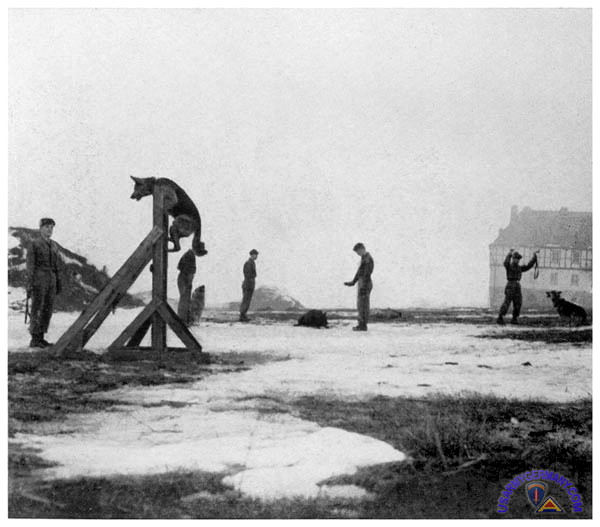 Dogs and handlers of the 33rd Inf Scout Dog Plt at Camp Wildflecken, early 1950s |
|||||||||||||||||||||||||||||||||||||||||||||
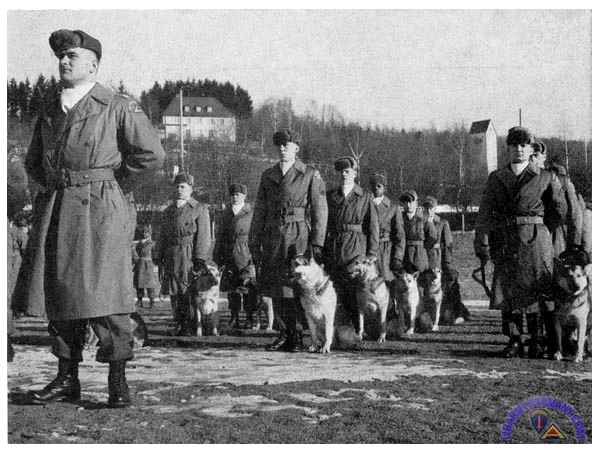 33rd Infantry Scout Dog Platoon stands at parade rest, early 1950s |
|||||||||||||||||||||||||||||||||||||||||||||
| 1956 | |||||||||||||||||||||||||||||||||||||||||||||
| (Source: READING EAGLE, November 4, 1956) | |||||||||||||||||||||||||||||||||||||||||||||
| Wildflecken, Germany -- In the
Pentagon the military brass talks of "battlefield television," ultra-sensitive radar and all the other electronic wonder weapons of push-button warfare. However, what does the U.S. Army use for its "eyes and ears" here on the Cold War front line smack up against the Iron Curtain? The German shepherd dog! The same German police dog made famous by the movie's Rin-Tin-Tin a generation ago. That's not all. The Army says it lacks bright young GIs to handle the dogs. The Army's elite canine unit is the 33rd Infantry Scout Dog Platoon, which is stationed at Wildflecken. GIs call their dogs "the infantry's radar." The tag is apt. For despite all the electronic gadgets spewing from the laboratories, none yet has been devised that can see and hear the soldier like the German shepherd. Scout dogs patrol the Iron Curtain in advance of troops. These dogs have hypersensitive hearing. They can detect sounds before the human ear catches it. What they don't hear, the dogs scent. The dog's reaction alerts the handler to the presence of hostile forces. Korea veterans here say that, in Korea, not a single patrol using a scout dog was ambushed. Handlers Are Screened In the 33rd Infantry Scout Dog Platoon, more than half the GIs assigned as dog handlers have been to college. All are screened for intelligence, emotional stability and patience. The Army values its dogs that highly. The GIs and their dogs are trained together, as a team, at Lenggries, in Bavaria. Here soldier and dog become an inseparable team, working, training and even traveling together. German shepherds are purchased in Germany by the U.S. Army's European Quartermaster School at Lenggries. Top price is about $150 per dog. Dogs, like their handlers, are hand-picked, the dogs for intelligence, adaptability to climate (when the GI leaves Germany his dog will accompany him), and temperament. The dog's rations are slim. Each dog gets a single meal a day, consisting of 1½ pounds of meat and 1½ pounds of dog meal. Trained for 12 Weeks At the age of 18 months, the dogs first are taken to Lenggries for a 12-week cycle in basic obedience training. Like the infantryman, they go through an infiltration course while live ammunition whistles overhead and flares burst. Over and over again, they go through this introduction to battlefield bedlam until they can do their job of scouting and patroling oblivious to the thunderous noise around them. From then on it's field work -- daily. Much of the time the dogs train directly with the infantry. Every morning, no matter how many months or years they have been at it, each dog is refreshed in obedience tactics, leaping over log hurdles of varying heights and marching in platoon formations. Then the dog is put in harness. The harness tells the dog it's time to hunt the enemy. A decoy hides in the woods, and the dog goes after him. Dogs have picked up the scent of foes as far as 800 to 1,100 yards. When the dog scents the decoy, he gives the alert. From the intensity of this alert, the GI handler can "read" the direction, distance and strength of the enemy. This is not theory. It happens all the time along the Iron Curtain. Many U.S. patrols, on delicate scouting missions along the curtain, have avoided encounters with Communist troops and patrols through the alert flashed by its scout dog. |
|||||||||||||||||||||||||||||||||||||||||||||
| Related Links: |
|||||||||||||||||||||||||||||||||||||||||||||
